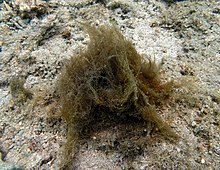Lyngbya majuscula
| Lyngbya majuscula | |
|---|---|

| |
| Lyngbya majuscula at Réunion | |
| Scientific classification | |
| Domain: | Bacteria |
| Phylum: | Cyanobacteria |
| Class: | Cyanophyceae |
| Order: | Oscillatoriales |
| Family: | Oscillatoriaceae |
| Genus: | Lyngbya |
| Species: | L. majuscula
|
| Binomial name | |
| Lyngbya majuscula | |
Lyngbya majuscula is a species of
.As a result of recent genetic analyses, several new genera were erected from the genus Lyngbya: e.g., Moorea,[1] Limnoraphis,[2] Okeania,[3] Microseira,[4] and Dapis.[5]
Almost 300 different secondary metabolites have been isolated from specimens identified as L. majuscula.[6] However, most of these studies lack a molecular identification of the samples. Several specimens identified as L. majuscula and collected in marine tropical regions are now classified as members of the genera Okeania and Moorea.
Antillatoxin and Kalkitoxin have been reported to be extracted from this microbe.[7] L. majuscula is the cause of seaweed dermatitis.[8]
Serinolamide A is a cannabinoid structurally related to Anandamide that has been found to occur in Lyngbya majuscula.[9]
References
- PMID 21724952.
- .
- S2CID 35379310.
- S2CID 206147172.
- PMID 29791035.
- ^ Blunt, J. W. & Munro, M. H. G. 2017. Marinlit Database. Department of Chemistry, University of Canterbury, Christchurch, New Zealand. Available at: http://pubs.rsc.org/marinlit/ (last accessed 24 May 2017).
- PMID 11757852.
- ISBN 978-0-7216-2921-6.
- PMID 21999614.
